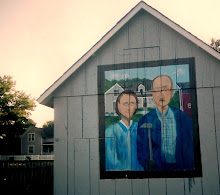 It's spring planting time. So with new acres, we got in line, and managed to get the no-till planter to plant grass and temporary pasture. Don was already home on 'lambing vacation', and the weather was good, so there was a whole lot of seeding going on.
It's spring planting time. So with new acres, we got in line, and managed to get the no-till planter to plant grass and temporary pasture. Don was already home on 'lambing vacation', and the weather was good, so there was a whole lot of seeding going on.By planting into the corn stalks, the soil surface was undisturbed, and the stalks act as mulch. Just because we aren't organic, doesn't mean we don't aim to be sustainable.
 I got to be the 'seed tender'. (Which means I drove the truck to the field).
I got to be the 'seed tender'. (Which means I drove the truck to the field).After a good deal of research, we selected a mix of grasses and legumes for a well rounded pasture that can be hayed or grazed depending on the growth and season.
We couldn't help but note that there is very little information about sheep. Everything is based on cattle or horse forage needs and preferences. But I guess we expected that.
 It may have been March 27th, but it was 80 degrees and sunny. Plums in full bloom, and the trees showing a hint of green.
It may have been March 27th, but it was 80 degrees and sunny. Plums in full bloom, and the trees showing a hint of green.In this patch, we sowed oats for temporary pasture. And then began the wait for rain.
The first chances didn't happen. Only a sprinkle.
The round green spots of the legumes began to show. Then the faint hair thin blades of grass began to emerge. Germination was good, but the hot dry days were making us nervous.
 But maybe today, the spell is breaking. Only a nice shower so far, but anything is welcome, and the chance for rain is on the board for 3 more days. I think maybe this is why farmers turn gray.
But maybe today, the spell is breaking. Only a nice shower so far, but anything is welcome, and the chance for rain is on the board for 3 more days. I think maybe this is why farmers turn gray.Meanwhile, back at the barn, the lambs continue. The first run of twins ended abruptly, and mostly singles has become the norm.
I'm impressed every year by how the color markings on the lambs so closely resemble those on horses. This is 'Blaze'. At least for the time being.
As the next generation of lambs emerge, its always a surprise. This year is no exception. With the addition of a new bloodline into the flock this year, we thought we had the basic genetic pattern figured out. Wrong. Of course a black lamb born to a white mother is not new. In fact, it has happened about 50 % of the time if the sire is black. So we had thought it was a simple recessive gene at work, even though we have been told it is not. Some times the 'book' is right. This year, we have had black lambs that should have been white, and white ones that should have been black - 2 black parents. Ah, well, that's farm life.
More rain, please.
Happy grazing to ya.

No comments:
Post a Comment